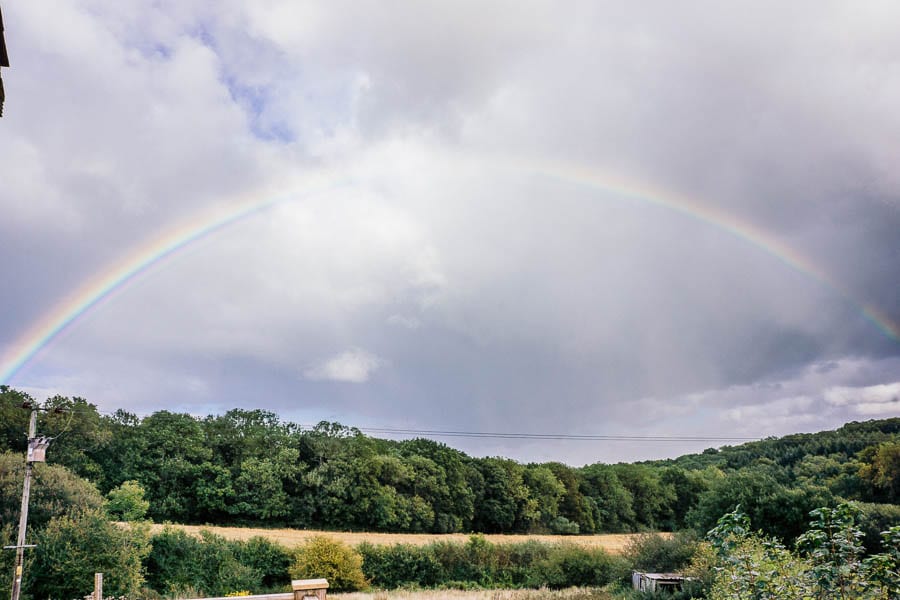
My guide to identifying and spotting what to forage in countryside hedgerows:
I don’t have to go far to forage. In fact I can do it in my garden and in the hedgerows around us here in southeast England. The rainbow over our valley and hedgerows this week didn’t lead me to a pot of gold but a treasure of berries, fruit, and more.
I’ve already written about the overabundance of Blackberries in some of our hedgerows. So many in fact that I’ve frozen masses for crumbles and more Blackberry fool this autumn. (Tip – first freeze the blackberries in rows on a baking tray and then put the frozen berries together in freezer bags)
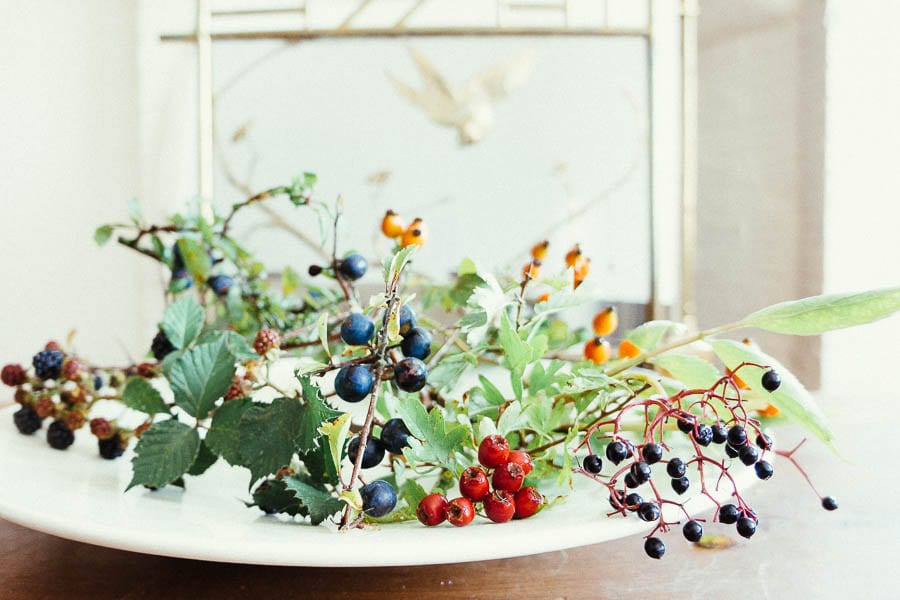
But in recent foraging expeditions I’ve found Sloe patches, Wild Plums, Haws, Rose hips, Dewberries, Elderberries, Water Mint, and even Wild Marjoram! There’s also been some poisonous berries lurking amongst them like dangerous bodyguards. Here and there Honeysuckle show up adding their sweet fragrance amid the thorns.
Did I mention Wild Plums?! At first I thought they were Sloes …anyway more below.
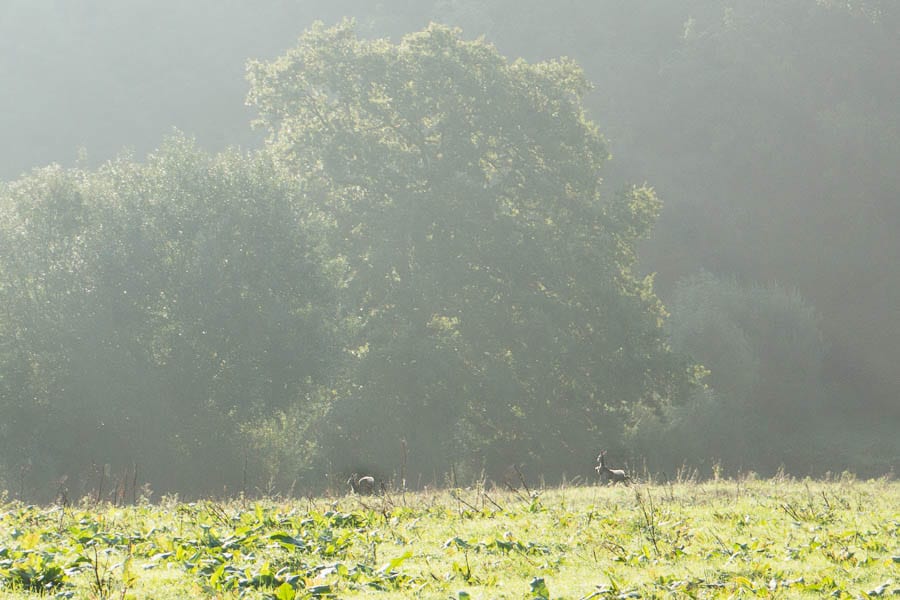
The deer are also clearly fond of some of the fruit as they love to shelter – or hide from me – in the undergrowth and trees by the hedgerows. Here are a couple this morning fleeing towards a hedgerow as I walked along the back of ours in the same field.
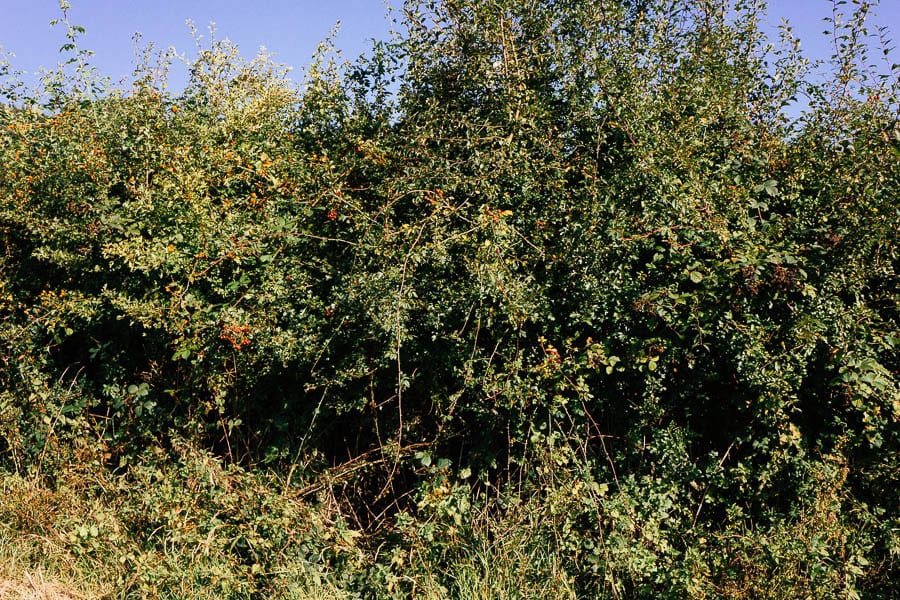
Foraging in the hedgerows
So without further ado, here’s what I found in the hedgerows, some of which I brought back home:
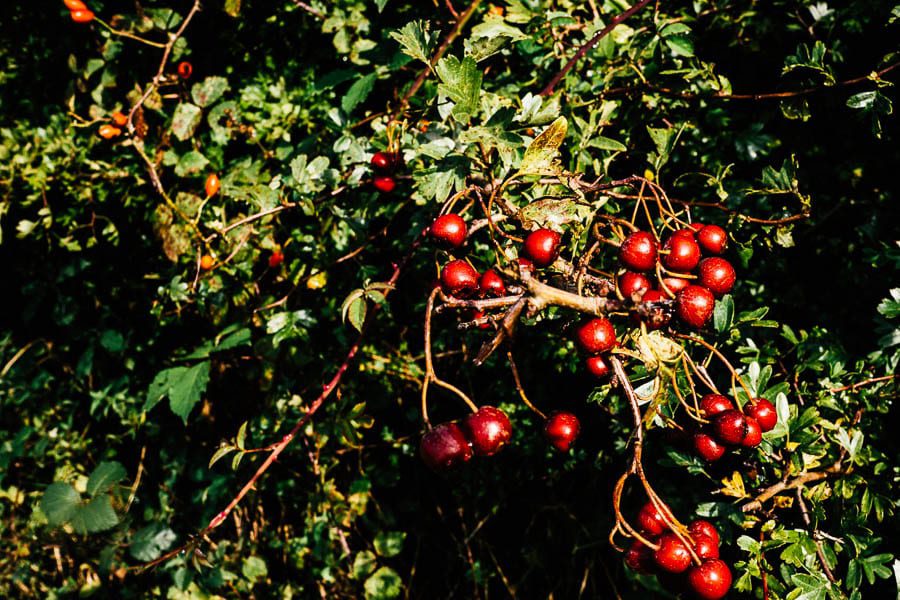
Hawthorn – Crataegus monogyna
Hawthorn berries, also known as Haws, (bright red in centre) and Wild Rose Hips (in left background).
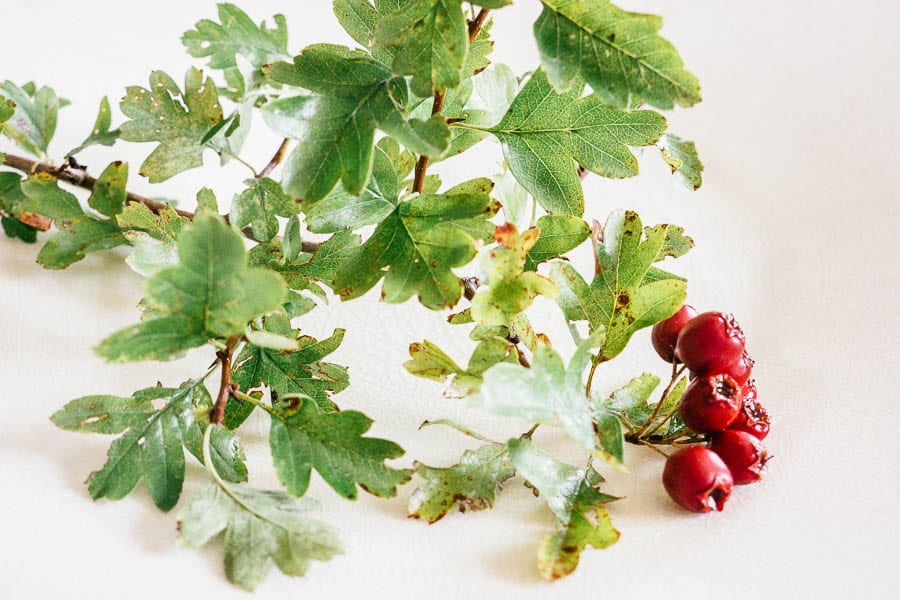
Hawthorn spiny branches and leaves
I never made anything with Hawthorn berries, but you can use them to make Haw jelly or fruit leathers.
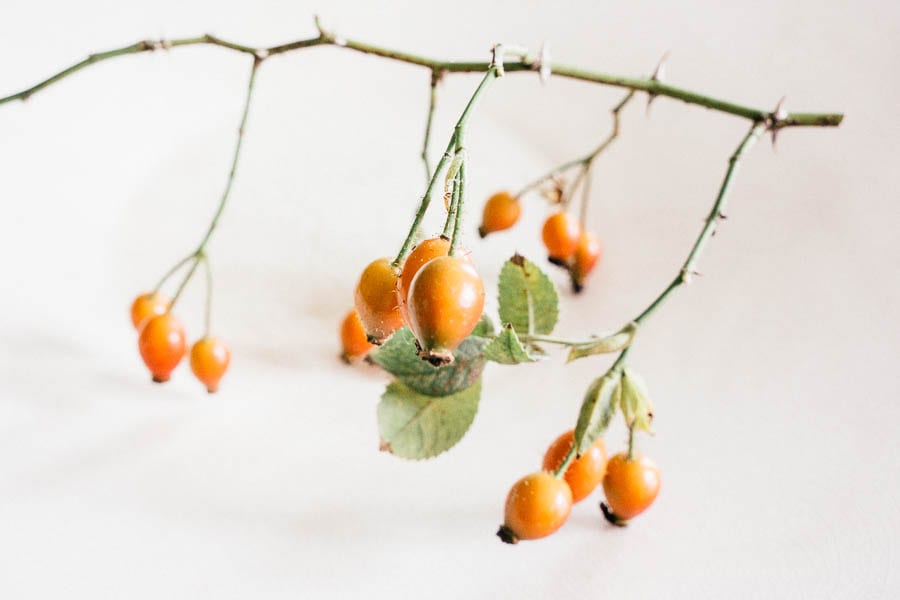
Wild Rose Hips (Rosa canina and/or Rosa arvensis)
These hips are from the wild Dog Rose – Rosa canina – which has white or pink flowers earlier in the summer. The rosebuds also have a pinkish colour. The Field Rose – Rosa arvensis – only has white rosebuds and then white flowers with styles fused in a column.
Wild rose hips are great for making rose syrup which can be used in cake recipes, jam, or even as sauce for ice cream. During World War II, rosehips were gathered and consumed extensively as rosehip syrup because of their high Vitamin C content – in fact 20 times as high as oranges.
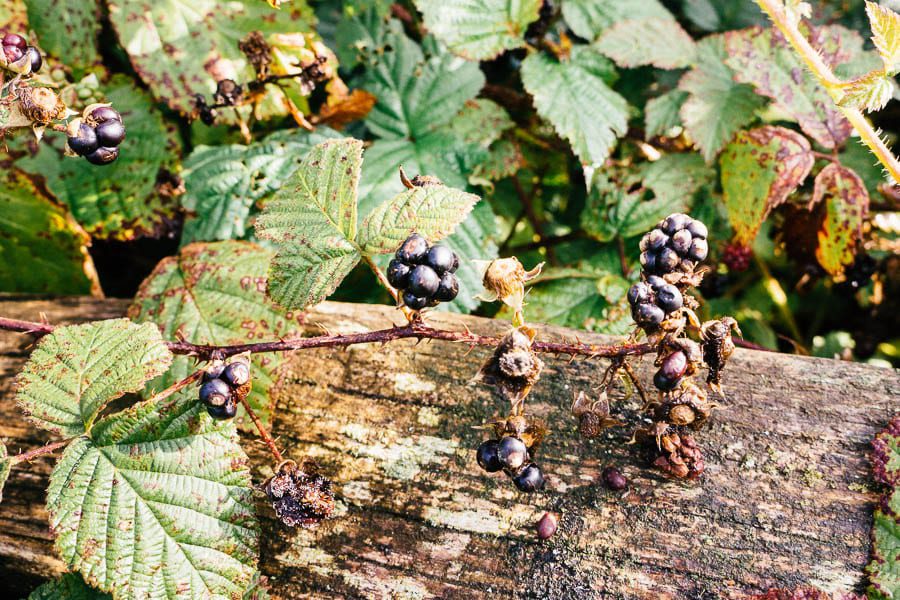
Dewberry (Rubus caesius)
Dewberries – they look like Blackberries with extra large druplets. They’re full of flavour and often burst when you pick them.
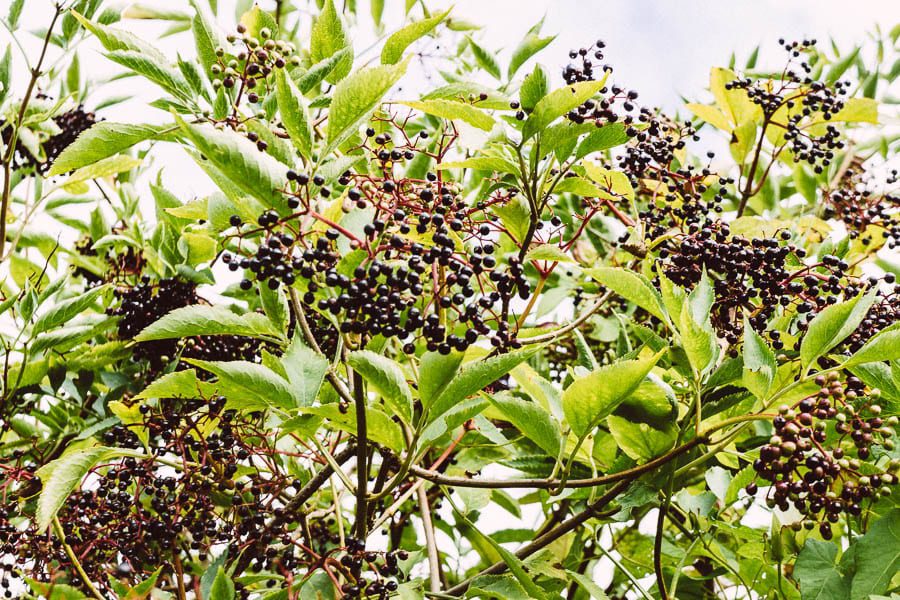
Elder (Sambucus nigra)
Elder shrub covered in Autumn berries. Elderberries should not be eaten raw as they are mildly poisonous, but cooked and boiled they can make wonderful Elderberry vinegar or simply as a refreshing juice drink. You can also make delicious Elderberry wine with the right equipment and ingredients. Earlier in the summer I always pick the flowers to make lots of Elderflower cordial which I also freeze. Here I’ve written a post where you can identify Elderflowers.
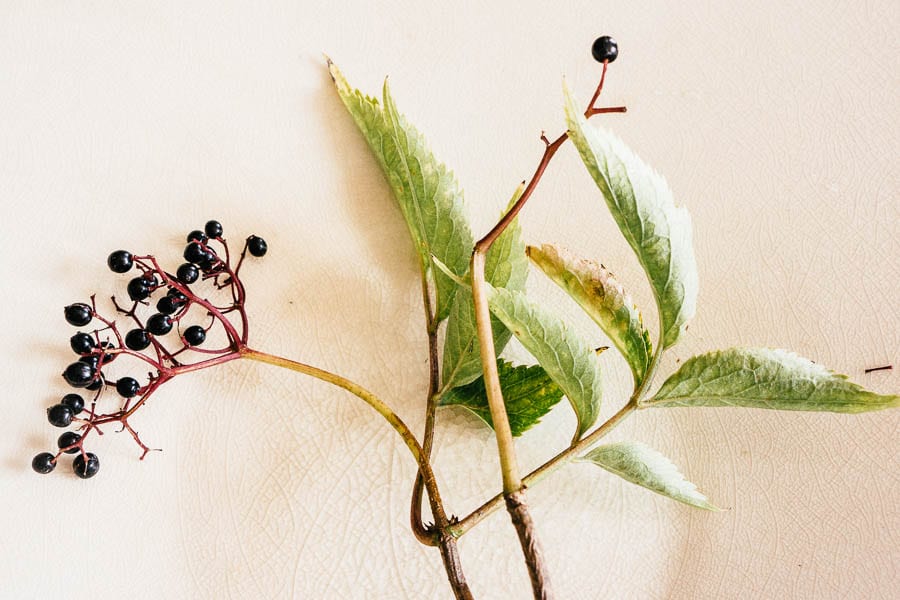
Elderberries
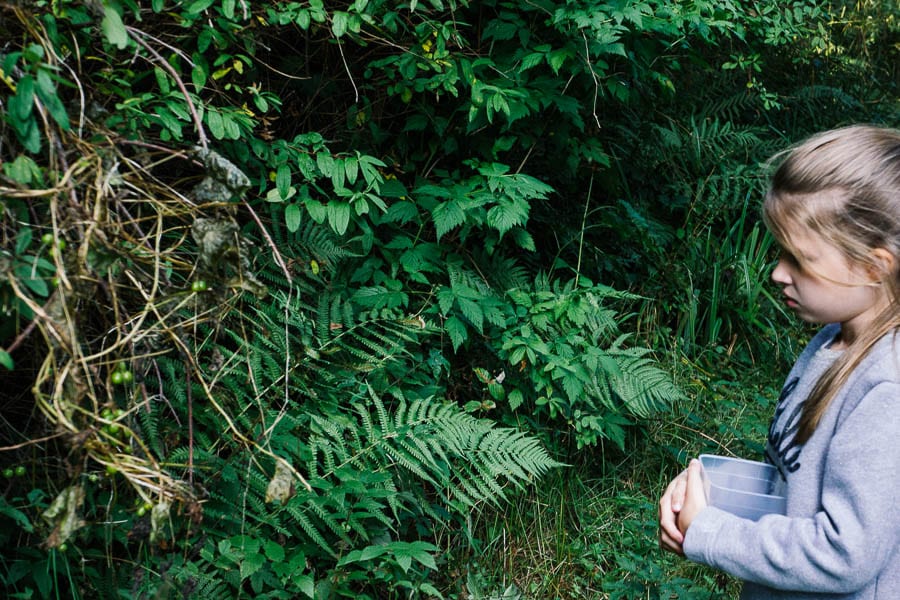
Beware of poisonous berries when foraging
Poisonous berries also made an appearance here and there – the little devils! When I’m foraging with my children I always explain to them what is safe to pick while making sure they avoid any toxic berries.
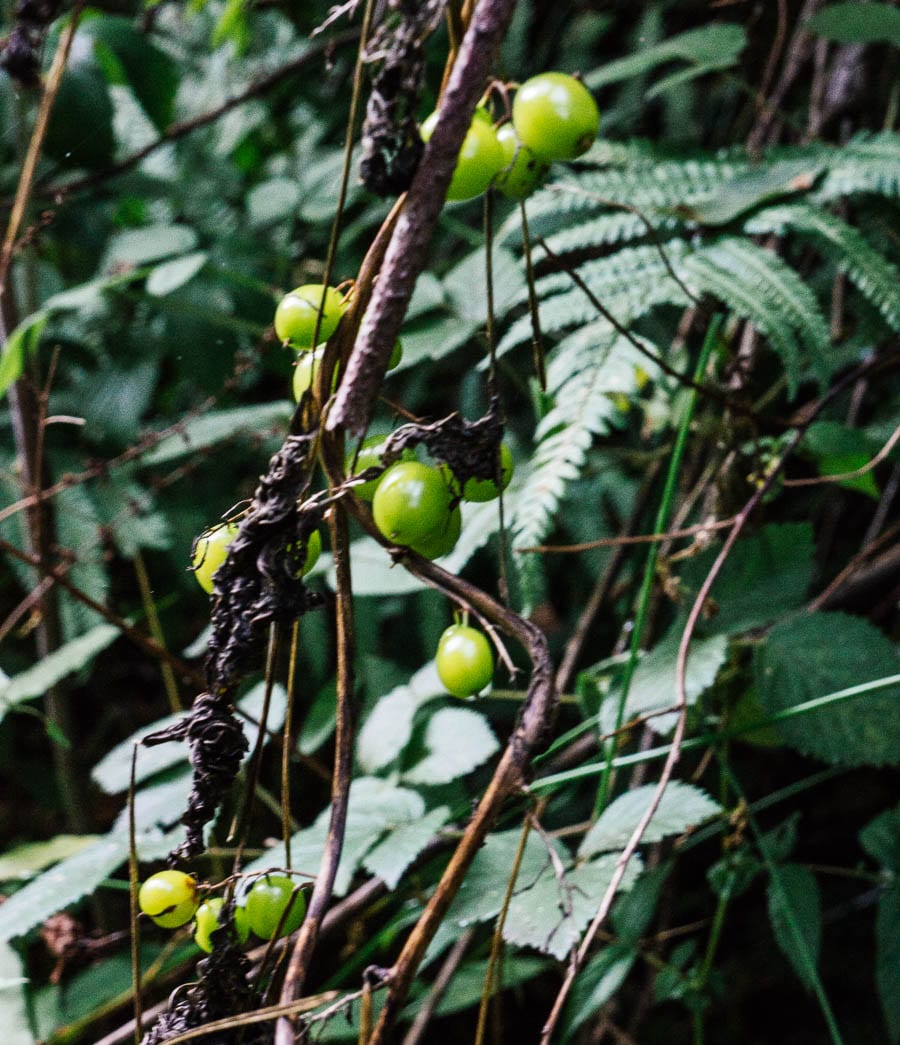
Black Bryony (Tamus communis)
Warning it’s poisonous! There are two Bryony berries that hide and clamber through the hedgerows which are toxic. Black Bryony (Tamus communis) has heart shaped leaves, no tendrils and is part of the Yam family. White Bryony (Bryonia dioica) has palmately-dobed leaves, tendrils along its twining stem and is part of the Gourd family. Both have green and red berries and often lose their leaves by Autumn.
Above you can see Black Bryony in the yellow and green immature stage, while in the next photo you can see the red stage berries hanging right next to blackberries.)
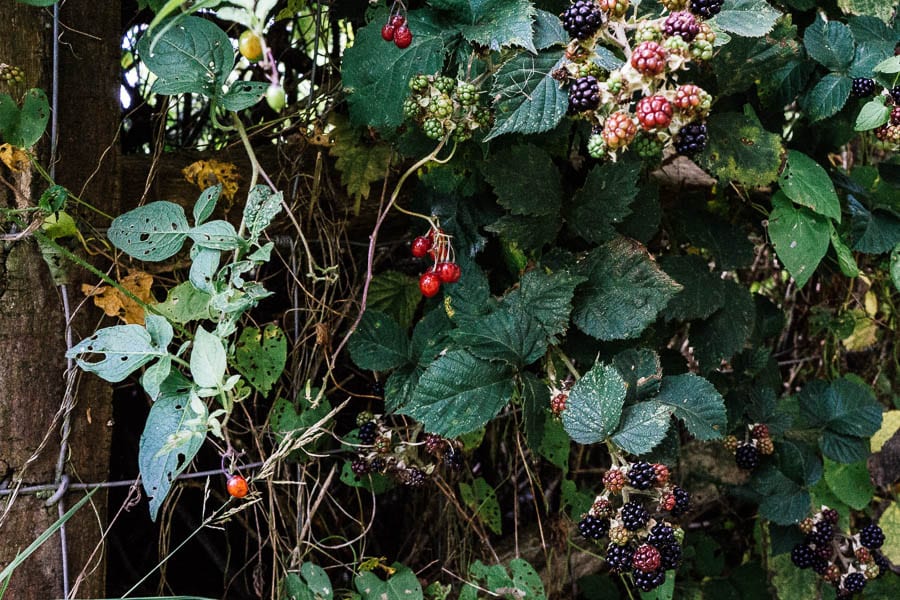
The small red berries hiding amid the bramble and delicious Blackberries are poisonous. Whether you call them Bittersweet, Woody Nightshade or Poisonberry, the berries turn from green to red in the autumn and are very toxic. On the bottom left you can see a red berry of the poisonous Black Bryony.
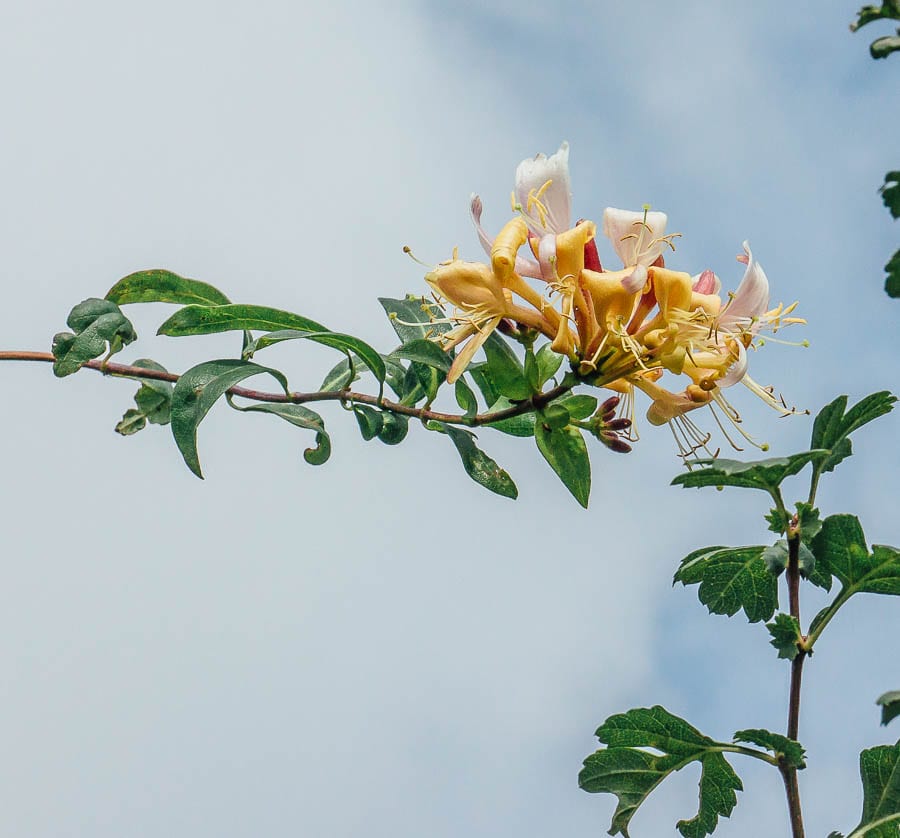
Honeysuckle
And on a pleasanter and more fragrant note, I’m still finding Honeysuckle flowers growing in the hedgerows. The flowers and berries are a feast for butterflies, bees, moths, birds, and dormice. Wild ones are not edible for us.
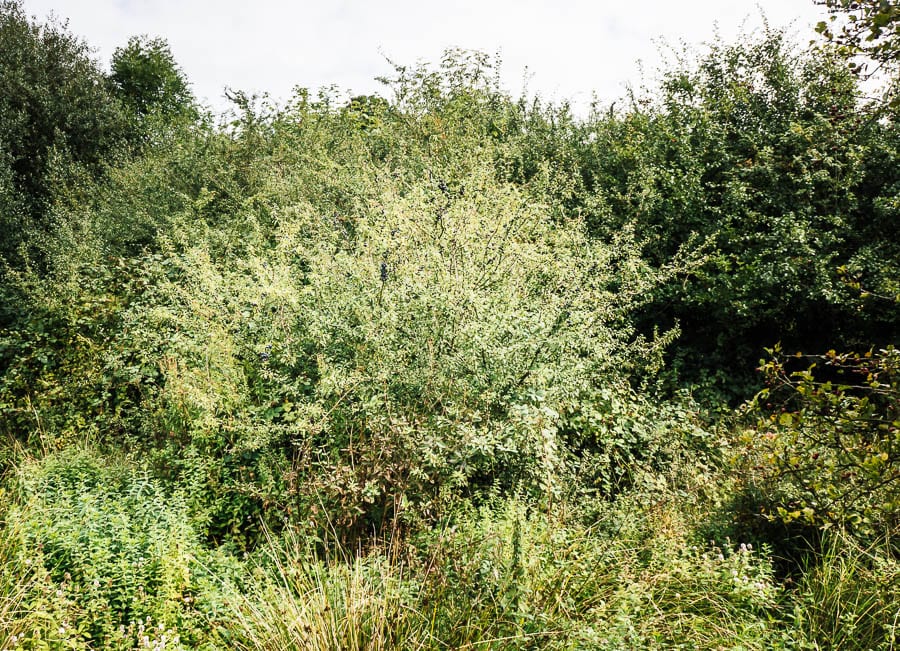
Wild Plum (Prunus domestica)
Wild Plum tree (above) in centre middle ground – plus wild Watermint (Mentha aquatica) growing in left and right foregrounds.
Careful!! When picking Watermint beware that the habitat is also favored by the very deadly Hemlock.
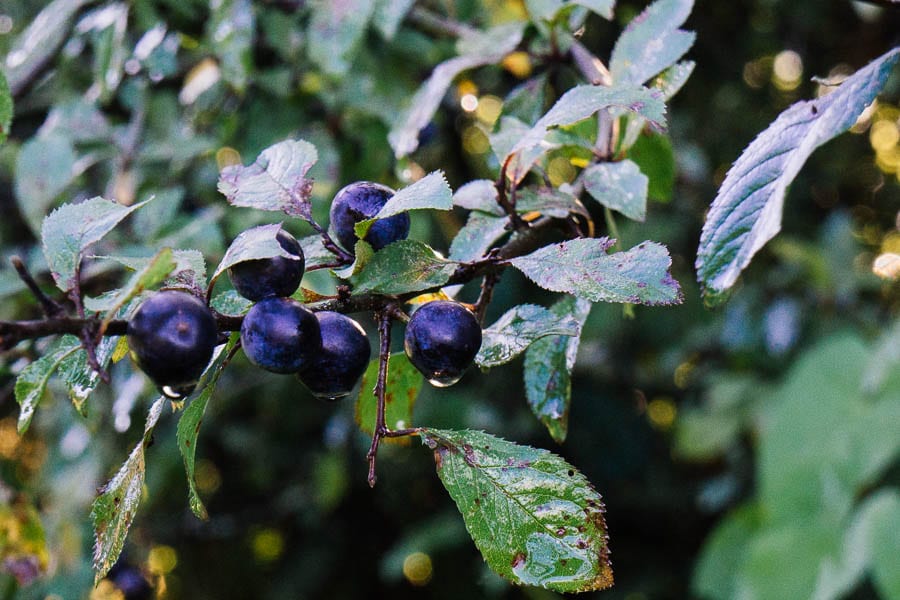
Now the best bit – I’m going to be making quite a few fruit flavoured gins this autumn. Yes, I found Wild Plums. And not just one tree but many.
At first I thought it was a Sloe patch but I could pick the wild plums without fear of sharp thorns. I also took a small branch to a friend who is a horticultural expert to confim my findings. There are quite a few different subspecies of wild plums, including Bullace. They are thought to be naturalised versions of cultivated plums, perhaps a hybrid of Blackthorn and Cherry Plum.
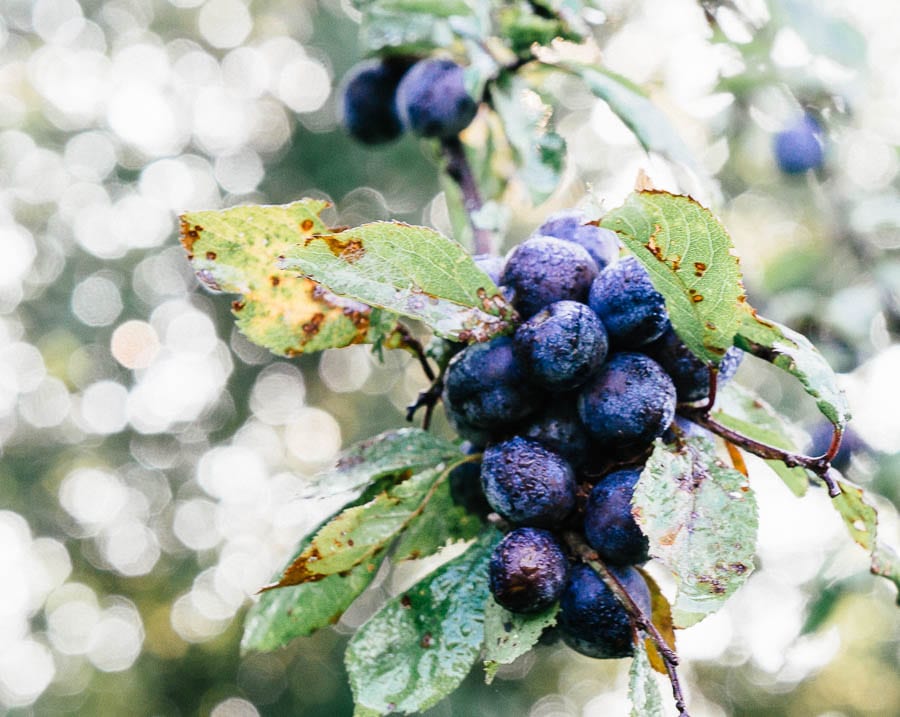
Wild Plums with dew drops – Prunus domestica.
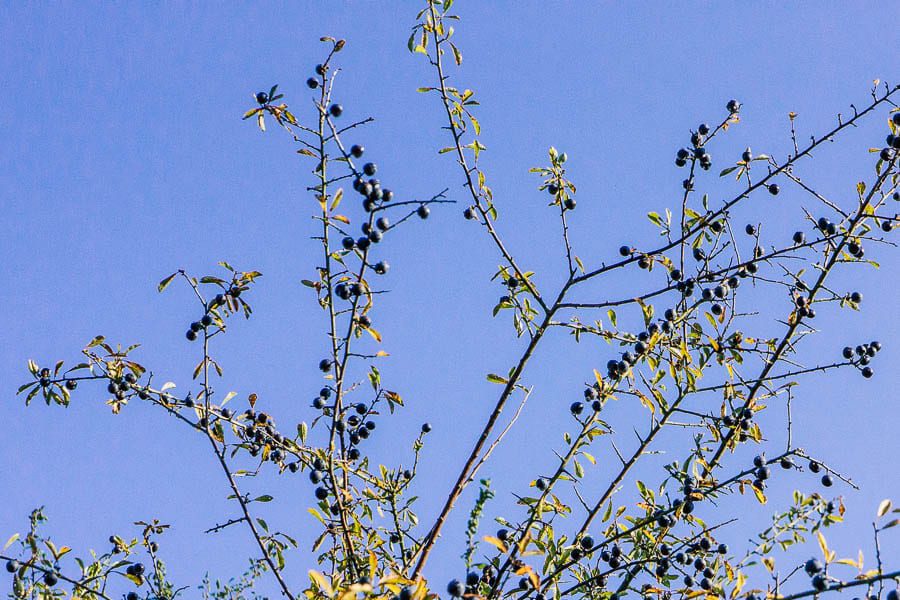
Blackthorn / Sloe (Prunus spinosa)
Usually known as Sloes, or Sloe berries, they are the fruit of the Blackthorn (Prunus spinosa) and probably the ancestor of the cultivated plum. Since the 17th century, when Blackthorns were planted as hedgerows following the Enclosure Acts in Britain, they have been popularly used to make Sloe Gin.
Sloe Gin can easily be made at home. I often make extra bottles to give away as gifts or use in recipes. You can also make a non-alcoholic Sloe cordial or Sloe and Apple Jelly.
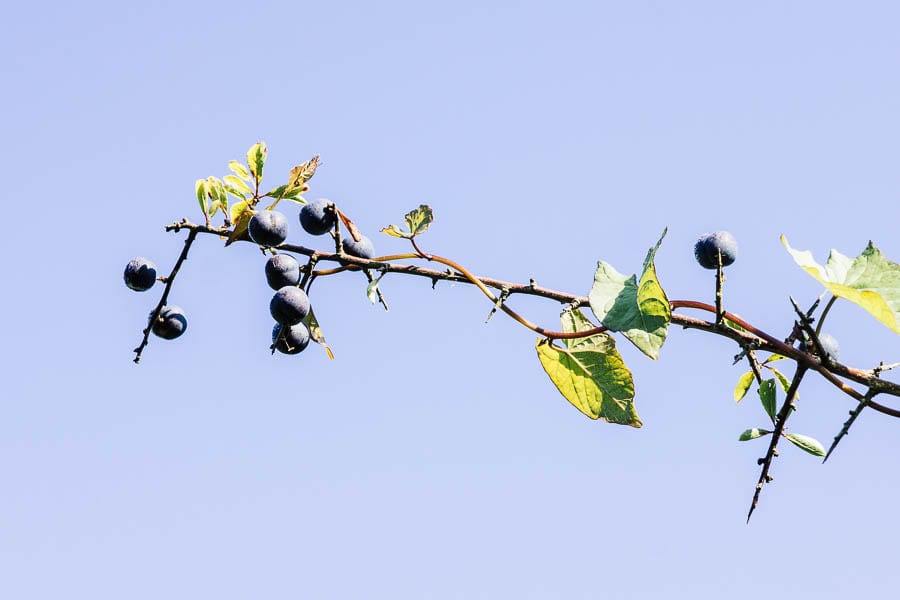
Blackthorns were already covered in Sloe berries. They have rather scary looking thorns.
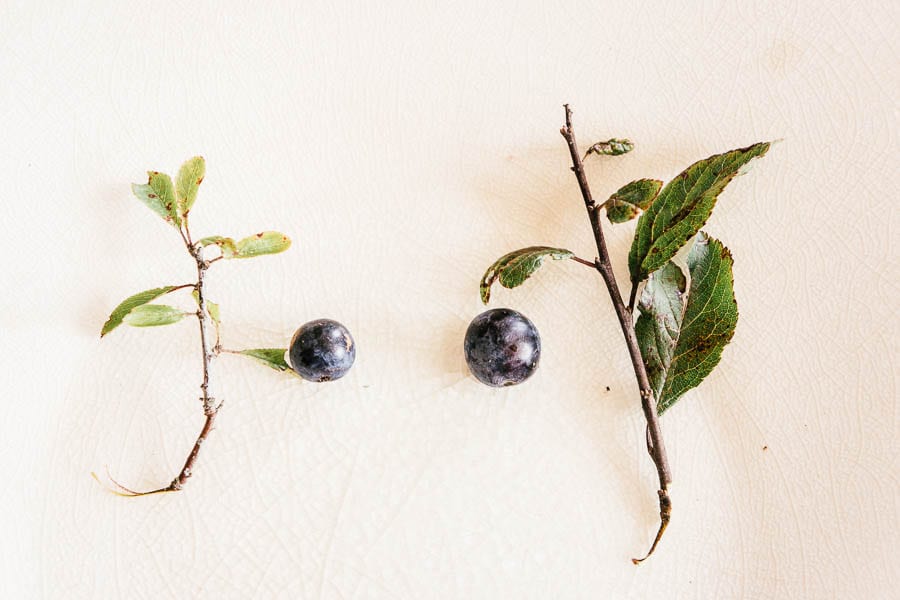
Another difference between the Sloe berries and the Wild Plum berries was the leaves. The Blackthorn had small oval shaped leaves while the Wild Plum tree had larger pointed oval leaves with blunt-toothed edges.
On the left is a Sloe plus a small stem from a Blackthorn. On the right is a small Wild Plum and a stem from its tree.
So I’m going to be feasting and drinking soon with the fruits from my hedgerow foraging. Time for Sloe Gin, Wild Plum Gin, and Blackberry Vodka! I’ve already picked one batch of Wild Plums which I’ve frozen but they’re still quite bitter. Luckily, as all the bushes and trees are practically in our garden, I can regularly check on how they’re ripening. I also don’t have to worry about foragers nicking them before I pick them!
So autumn is rather fruitful and I’m looking forward to some good tipples this winter.
In September I also went on a mushroom foray with a guide on a friend’s estate. I’ve also been collecting some of the flowers from our garden as well as these treasures from the hedgerows to fill up the vases in our home. Have you been foraging too?

thank you for the info on the sloe and wild plum, we saw some sloes on a walk around Bristol earlier this month and my MIL said she thought they were wild plums, but having looked at my picture now and comparing the leafs I can tell her to go a head and pick them for her sloe gin
How lucky you are to have such a bounty on your land, I love the idea of foraging – I’ve done blackberries and bilberries but not a lot more. I’d not heard of a bullace before, like a new bit of knowledge 🙂
I am such a forager and this year is proving to be very productive – I have never seen so many blackberries and the rose hips are almost ripe for picking. Mind you I really should not pick any sloes until I have made the ones I picked last year into jelly … but I know I will! Have you cooked with hawthorn berries – I tried to make haw ketchup one year but it failed as apparently there is only a short time when they are good to pick and I definitely missed that window.
I might try to make Crab Apple and Hawthorn fruit leather sometime but they’re probably best made in an Aga where you can put them in one of the low heat ovens for at least 12 hours!
Wow look at all that beauty – never mind free food and drink. I have to admit I was taught never to pick anything as you don’t know what is poisonous rather than be taught. I think I shall pick now and come back to this handy guide!
Thank you! I tried to take some clear photos as I often go nuts trying to identify some of the fruits and flowers 🙂
Oh some lovely finds 🙂
Kriss, you live in a magical place. rainbows and all. so beautiful!
Thank you Claudia – I do love our little valley surrounded by woods!
Oh such treasures! I’m ashamed to say I’ve not been out much in the past 2 weeks around here, what with being away and now the sickness and tiredness of jetlag which seems to be taking an age to vanish. You have really inspired me to go out and forage some bits to bring inside and display in our home. You really do love in a beautiful part of the country x
You’re going to have to taste the gins I brew up this winter with my foraging Annie!
Although I live in the city suburbs there is an abundance of blackberries, damsons, apples and elderberries around the paths this year. I must get some more tomorrow to do some more preserving over the weekend.
I learnt about freezing blackberries the hard way! The first year I did it, I put them all in a bag at once. They froze into a solid ball big enough to knock out a wooly mammoth!! I love everything in this post, full of the seasons bounty. Autumn is my favourite time of year and you’ve captured it beautifully.
hehe just thinking of the dangerous frozen blackberry ball! And thank you Gemmma.
How brilliant – you’ve made me realise just how little I know about foraging! I bet it’s a rather addictive pastime – particularly with the promise of gin at the end of it all 😉
It’s new for me but I love it!
Love that arrangement in the second photo – definitely bringing the season indoors. I was out today looking for blackberries down by the Thames, mixed results but I have a tub full which is better than nothing! Lovely to have all this on your doorstep, I might resort to damsons from the greengrocers as I don’t think I’ll find anything nearby, but we’re off to devon in a week or so so I’ll be taking my tubs just in case!!
I popped over to a friend’s garden earlier this week to get some damsons but there were none compared to last year. Realised it was a biennial fruiting tree! Hopefully we’ll have lots of wild plums next year too.
Wow, fabulous Kriss! You are going to have some wonderful treats 🙂 It’s great to see the leaves and fruits, I’m useless at identifying plants!
I’ve learnt to identify so many of the plants and fruits as we’re surrounded by them. Also rather looking forward to tasting some of them with gin and vodka 🙂